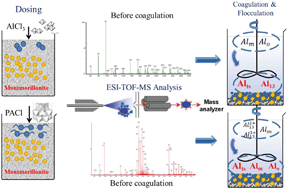A novel understanding of residual nano-Al13 formation and degradation during coagulation and flocculation: a proof based on ESI-TOF-MS†
Abstract
Nano-Al13 clusters have the potential to form and remain in a coagulation process, but cannot be directly traced by traditional instrumental techniques in real time since there is only a trace concentration after being dosed. In this study, an optimized electrospray ionization mass spectrometry (ESI-MS) method was introduced for the first time to determine the coagulation pathways when using AlCl3 (monomeric Al, i.e., Alm) and polymeric aluminum chloride (PACl) as coagulants. The transformation mechanisms of Al clusters, including Alm, oligomeric Al (Alo), Al13 and transient Al (Alts), were clearly elucidated using statistical analysis and a real-time tracking experiment. The nano-Al13 clusters could be detected in the coagulation batch experiment conducted using AlCl3 as the coagulant. Moreover, using a statistical method, the Al13 clusters in the PACl coagulant and the Al13 clusters formed by AlCl3 coagulation were confirmed to be an efficient coagulant species. In the real-time tracking experiments, the reversible transformations among Alm, Alo, Al13 and Alts clusters were instantly observed after the addition of the coagulant (i.e., during the coagulation process). In the subsequent process (i.e., the flocculation process), only floc aggregation occurred, and no obvious transformations among the four types of Al clusters were observed. The continuous aggregation and increase in floc were mainly attributed to particle coalescence with the Al clusters. The mineral–water interface was inferred to favor the transformation of Alm and Alo aggregates into Al13 as well as the reverse reaction (e.g., the degradation of Al13).



 Please wait while we load your content...
Please wait while we load your content...